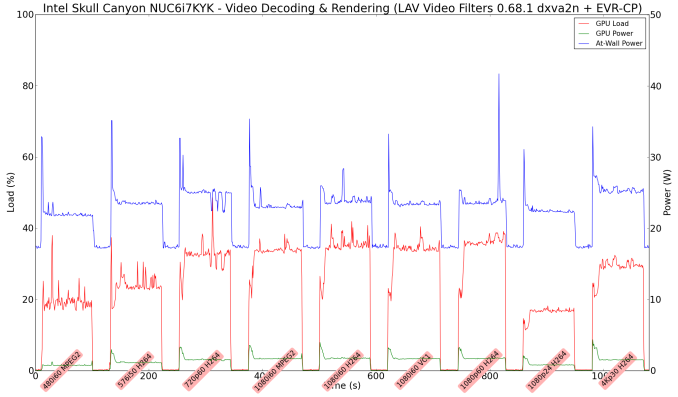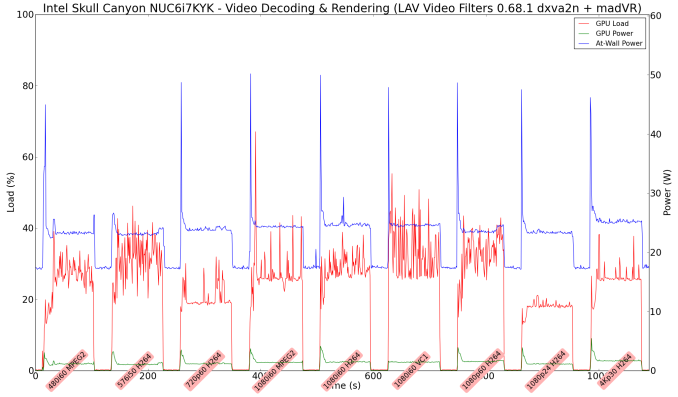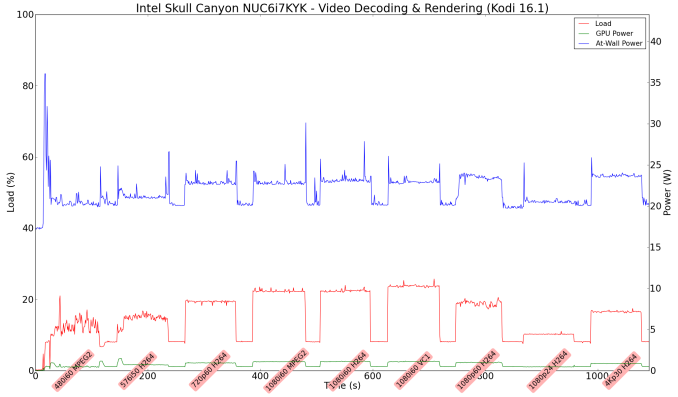The Intel Skull Canyon NUC6i7KYK mini-PC Review
by Ganesh T S on May 23, 2016 8:00 AM ESTHTPC Credentials
The higher TDP of the processor in Skull Canyon, combined with the new chassis design, makes the unit end up with a bit more noise compared to the traditional NUCs. It would be tempting to say that the extra EUs in the Iris Pro Graphics 580, combined with the eDRAM, would make GPU-intensive renderers such as madVR operate more effectively. That could be a bit true in part (though, madVR now has a DXVA2 option for certain scaling operations), but, the GPU still doesn't have full HEVC 10b decoding, or stable drivers for HEVC decoding on WIndows 10. In any case, it is still worthwhile to evaluate basic HTPC capabilities of the Skull Canyon NUC6i7KYK.
Refresh Rate Accurancy
Starting with Haswell, Intel, AMD and NVIDIA have been on par with respect to display refresh rate accuracy. The most important refresh rate for videophiles is obviously 23.976 Hz (the 23 Hz setting). As expected, the Intel NUC6i7KYK (Skull Canyon) has no trouble with refreshing the display appropriately in this setting.
The gallery below presents some of the other refresh rates that we tested out. The first statistic in madVR's OSD indicates the display refresh rate.
Network Streaming Efficiency
Evaluation of OTT playback efficiency was done by playing back our standard YouTube test stream and five minutes from our standard Netflix test title. Using HTML5, the YouTube stream plays back a 1080p H.264 encoding. Since YouTube now defaults to HTML5 for video playback, we have stopped evaluating Adobe Flash acceleration. Note that only NVIDIA exposes GPU and VPU loads separately. Both Intel and AMD bundle the decoder load along with the GPU load. The following two graphs show the power consumption at the wall for playback of the HTML5 stream in Mozilla Firefox (v 46.0.1).

GPU load was around 13.71% for the YouTube HTML5 stream and 0.02% for the steady state 6 Mbps Netflix streaming case. The power consumption of the GPU block was reported to be 0.71W for the YouTube HTML5 stream and 0.13W for Netflix.
Netflix streaming evaluation was done using the Windows 10 Netflix app. Manual stream selection is available (Ctrl-Alt-Shift-S) and debug information / statistics can also be viewed (Ctrl-Alt-Shift-D). Statistics collected for the YouTube streaming experiment were also collected here.

Decoding and Rendering Benchmarks
In order to evaluate local file playback, we concentrate on EVR-CP, madVR and Kodi. We already know that EVR works quite well even with the Intel IGP for our test streams. Under madVR, we used the DXVA2 scaling logic (as Intel's fixed-function scaling logic triggered via DXVA2 APIs is known to be quite effective). We used MPC-HC 1.7.10 x86 with LAV Filters 0.68.1 set as preferred in the options. In the second part, we used madVR 0.90.19.
In our earlier reviews, we focused on presenting the GPU loading and power consumption at the wall in a table (with problematic streams in bold). Starting with the Broadwell NUC review, we decided to represent the GPU load and power consumption in a graph with dual Y-axes. Nine different test streams of 90 seconds each were played back with a gap of 30 seconds between each of them. The characteristics of each stream are annotated at the bottom of the graph. Note that the GPU usage is graphed in red and needs to be considered against the left axis, while the at-wall power consumption is graphed in green and needs to be considered against the right axis.
Frame drops are evident whenever the GPU load consistently stays above the 85 - 90% mark. We did not hit that case with any of our test streams. Note that we have not moved to 4K officially for our HTPC evaluation. We did check out that HEVC 8b decoding works well (even 4Kp60 had no issues), but HEVC 10b hybrid decoding was a bit of a mess - some clips worked OK with heavy CPU usage, while other clips tended to result in a black screen (those clips didn't have any issues with playback using a GTX 1080).
Moving on to the codec support, the Intel Iris Pro Graphics 580 is a known quantity with respect to the scope of supported hardware accelerated codecs. DXVA Checker serves as a confirmation for the features available in driver version 15.40.23.4444.
It must be remembered that the HEVC_VLD_Main10 DXVA profile noted above utilizes hybrid decoding with both CPU and GPU resources getting taxed.
On a generic note, while playing back 4K videos on a 1080p display, I noted that madVR with DXVA2 scaling was more power-efficient compared to using the EVR-CP renderer that MPC-HC uses by default.




















133 Comments
View All Comments
KurtKrampmeier - Tuesday, May 24, 2016 - link
Can Undervolting achieve significantly better thermals and less cpu throttling? And if so, by how much? I want to use this as a 24/7 load and very small and light portable cpu package. Thank you!Drazick - Tuesday, May 24, 2016 - link
Ganesh, When will we have high TDP (65W and above) CPU with Iris Pro?I would even go farther, I'd like to see Extreme Edition CPU's with Iris Pro.
I hope Core I7 7820K will also have a configuration with Iris Pro and 128MB of eDRAM.
It's time Intel to bring Iris Pro to the high end desktop chips.
sharath.naik - Wednesday, May 25, 2016 - link
Not sure about the price. At this price isnt it just better to buy a Laptop with discrete graphics and remove the display if you donot want it?Eva Green - Thursday, May 26, 2016 - link
The PC provides cutting edge hardware to run the best games ->http://www.gamernode.com/the-pc-power-and-money-in...
cm2187 - Saturday, May 28, 2016 - link
Just received mine. It is quite noisy, even when idle.Madpacket - Monday, May 30, 2016 - link
Neat computer but niche. I'll wait for the fire sale on this one. I could see uses as a dev / portable VM box with the m.2 PCI ports (raid striped). As a gaming machine this thing is about as useful as a A10-7870K or even less for driver reasons. But at least it can do some low end gaming however you would be much better off with an Alienware Alpha which is still tiny and packs a real GPU and is about half the price.gue2212 - Saturday, June 4, 2016 - link
"Connecting the Thunderbolt ports on the two machines and allowing the PCs to talk to each other automatically creates a 10Gbps network adapter."Can anyone shed some light: When TB3 can transfer 40Gbps (bundle the 4 PCIe 3 lanes), why do we end up with 10Gbps USB 3.1 Gen2 speed for networking?
Well, woulda been too good at 40, but I guess I´ll abuse the NUC6i7KYK as an external storage (partition backup) for my Dell XPS 9550 until I see a TB3 SSD with the Samsung T3 SSD form-factor. ;-)
mystikmedia - Thursday, June 9, 2016 - link
I have this NUC. I am very happy with it overall. I can't seem to get the Thunderbolt port to work, though. I bought a USB 3.0 hub that has a Type C connection. I figured I might as well put that Type C port to use and not waste an existing USB port. But, it doesn't seem to work. Should it? I had assumed the USB 3.1 aspect of it would be backwards compatible with 3.0, as has been the case in the past. Is that incorrect? TIAgue2212 - Saturday, June 18, 2016 - link
Hey mysticmedia,I don´t understand what you´re trying to accomplish. You got 4 USB 3.0 ports on the NUC6i7KYK. Why in heaven would you hook up a USB 3.0 hub to the TB 3?
gue2212 - Sunday, June 19, 2016 - link
How are the connectors / headers supposed to be used (left back cut-out in the metal under the top plastic cover)?According to the circuit schema they are internal USB 3 and 2, NFC and LPC Debug.